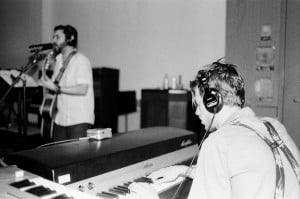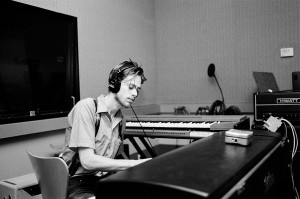The Challenges of Recording After Your Studio Sells Their Console
PRE-PRODUCTION
What was your pre-production like on this project?
We have had these songs for a while, and played out regularly. The songs were well rehearsed; it was just a matter of finding the right time and place [to record them].
We knew we wanted a different approach from the lo-fi home recordings we’ve done in the past.
When we found out about Engine Studios and that there was open time available, we just jumped on it. It was really a happy coincidence.
Why did you record at Engine Studios?
To be honest, I hadn’t heard of Engine Studios until our then bassist encouraged us to check it out. Turns out a good friend of his and fan of the band had been working there as an engineer for the past year and a half. After seeing the gold records on the wall from Iron and Wine and Modest Mouse, I quickly became intimidated and excited. I knew right then this was a once-in–a-lifetime opportunity for humble garage rock band to record a huge sounding album that might get some attention. The studio was set to relocate in a couple months so we actually snagged some of the last available studio time.
PRODUCTION
What kind of sound were you looking for and how did you achieve it?
We wanted an album that was super clean, clever and interesting sounding. We wanted to throw everything we had at this album by getting some of our talented friends to add some amazing things to it.
How does it compare to your last release in terms of style and the creative process?
We actually re-recorded a couple of songs because previous recordings just didn’t do the songs justice. We didn’t have access to all the tools and equipment necessary to capture the songs in a way we were happy with.
Did you use any special gear or recording techniques on this one?
The Sphere Eclipse C console is extremely rare, one of only 15 or so. It was great to have access to that – doesn’t hurt that it sounded phenomenal as well. Outside of all the other really great equipment listed above, we mainly stuck with simple and effective recording techniques. The focus was on getting the best and most natural sounds from the source so we didn’t have to spend a lot of time messing with things in the mixing phase.
What was your philosophy on live, full-band takes versus individual tracking?
It really depends on what the situation calls for. The live element is definitely important for the sound of this band, and the energy is much better with everyone playing together in the room at the same time. We tracked drums, bass, keys, and guitars live for this one. Later on we overdubbed acoustic guitar, piano, additional percussion, flute and the main vocal tracks. Some things just work better as an overdub.
Any special guests?
Will Huelsman from Teenage Rage on keys and vocals. Natalie Grace from the The Boombox Face played organ and clavinet. Liliana Carriz added flute and accordion. Outside of engineering, Mike [Novak] also laid down some percussion tracks and über-feedback electric guitar parts.
What did you try to accomplish in the studio that you’re not able to do live?
I have always been told that we were much better as a live band. I wanted to prove to everyone that we could make a quality studio recording, as well. Doubled vocals and guitars, multiple piano tracks, and auxiliary percussion are things we can’t really do live, but go a long way in the studio.
What were the toughest challenges you faced?
Since the studio was relocating, they actually sold the console we started on. This worked out well because we got upgraded to the Sphere in the A room, but there were definitely a couple late nights. Mike [Novak] ended up mixing the entire record in his apartment. Also, getting all the people involved on the same schedule is always a difficult task.
Any funny stories from the session that you’ll be telling for a while?
The song “Two Fools in Love” is a vocal duet between Will and myself. We used one mic and sang together in the live room with all the lights out. I think we did about nine takes, each more ridiculous than the last. Mike and Max [Brink, bass] were literally crying from laughter in the control room.
POST-PRODUCTION
How did you handle final mixing and mastering?
Mike had to do all the mixing at home since the studio was no more. Once it came time to mix the record, we kind of anticipated this and made sure to get the best tones possible on the way in. My old friend [Hans DeKline] from the late-’90s band Maypole in L.A. took care of the mastering at his mastering house Sound Bites Dog.
What are your release plans?
Bandcamp, iTunes, Spotify and anywhere digital music is sold.
ALBUM INFO
- Band Name: Bad Bad Meow
- Album: Run Through the Middle EP & Drink and Regret EP
- Recording Studio: Engine Studios
- Record Label: Unsigned
- Release Date: January 1, 2013 for RTM EP; TBA for the D&R EP
- Produced & Engineered by: Mike Novak
- Mastered by: Hans DeKline (Sound Bites Dog)
- Artwork by: Tika Lynn
KEY GEAR
- A whole slew of some of the finest recording gear available. Highlights include:
- Sphere Eclipse C console
- Trident 80B console
- Vintage Neumann tube mics including: m49, u64, m367
- RCA KU-3A directional ribbon mic
- EMT 140 and 240 “gold foil” plate reverbs
- Electronaut M63 hand built tube mic preamp
- Fender Rhodes, Hammond M3 organ, Hohner Clavinet
Have a unique studio story to share? Email [email protected].
photos by Kyle Sullivan


